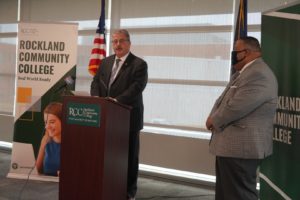While the individual and industry-wide struggles of hospital workers have been in the public eye for the duration of the pandemic, another sector of health care service providers has been facing its own strains as well. According to a survey from the American Ambulance Association, nearly a third of the emergency medical service industry”™s workforce left their agency after less than a year.

Tim Egan, chief information officer at Rockland Paramedics, a nonprofit advanced life support service operating in Rockland County, said that the lack of qualified emergency medical technicians (EMTs) and paramedics has hit the lower Hudson Valley hard, but extends across the country as well.
“There”™s been a significant shortage in providers both at the EMT and paramedic level,” he said. “It really started before the pandemic, but the pandemic really accelerated those losses to the industry and health care industry overall. In EMS in particular, it”™s really tough right now. We as an organization are probably down about 25% in paramedic availability and employees, and on average about 40% with EMTs. It depends on the day, but we”™ve been down about 50% to 60% in EMT coverage on any given day, and that”™s pretty serious, because this has downstream trickle effects into the rest of the health care system.”
A report from the New York State Department of Health”™s Bureau of EMS also reports that the number of certified providers in the state has declined by 9% in the past decade.
Not only can this shortage of workers seriously affect the response time for people having medical emergencies, it can also back up hospitals due to a lack of medical transport options.
This is a critical issue for both the health care system and the community at large, so it only makes sense that health care providers and community leaders are teaming up in Rockland County to address it. Through a new partnership with Rockland Community College (RCC), Rockland Paramedics, the Workforce Development Board of Rockland County and the Rockland Works Career Center, students interested in becoming emergency medical technicians at the basic level can take the three-month course potentially for free and be placed immediately into a paid position with Rockland Paramedics upon completion.
The program is intended to target both the needs of the industry and the need for greater opportunity for those who are unemployed and underemployed, especially those impacted by the pandemic.

Back Row (Left to Right): Dr. Mark Geller, CEO, Montefiore Nyack Hospital; Timothy Egan, CIO, Rockland Paramedic Services and Lucy Redseposki, Director, Rockland County Department of Economic Development.
Although there are many volunteer agencies in the numerous municipalities around Rockland, Egan explained that there is still a lot of opportunity for paid EMS workers, because even most volunteer agencies rely on paid staff regularly for hours that cannot be filled by volunteers.
Michael Baston, president of RCC, said that the college began to seek out ways to establish pipelines for students to get into important opportunities in health care even before the pandemic began, but wanted to find more intentional, shorter-term ways to help the community after it hit the region hard.
“This is a new, first of its kind program,” Baston said.” And the thing that’s distinctive about our program is this: most times, schools decide what they want to do and say to the community, ”˜Hey, here’s what we have to offer.”™ What we did was we met with the actual EMT and paramedic groups and said, ”˜What should we offer?”™ And co-designed the offerings with those who actually need the help. And that is different. It’s not just an education institution on its own making decisions for folks, but by co-designing these kinds of programs, business and industry will ultimately get exactly the kind of folks they need. And if we can find appropriate ways to fund it, it just makes all the difference.”
The first cohort will begin training at RCC on Jan. 24 and finish around the end of April. It has 18 spots, and Baston said that the program received 17 applications in just the first few days.
It costs $6,997, but is free for individuals who qualify for assistance through the Workforce Innovation and Opportunity Act. Those individuals can inquire about applying for those benefits through the Rockland Works Career Center; minimum requirements such as a high school diploma or GED along with fluency in English are also needed.
According to Egan, Rockland Works and the Community Development Board were both integral in providing funding for the program, while leaders from Good Samaritan Hospital in Suffern and Montefiore Nyack Hospital have been involved in medical direction for it.
Dr. Mary Leahy, CEO of Bon Secours Charity Health System, which operates Good Samaritan Hospital, Bon Secours Community Hospital in Port Jervis and St. Anthony Community Hospital in Warwick, pointed out that the program is not only beneficial to short-term EMS operations, but also can encourage individuals to go into a career in the health care field.
“I think having a pipeline for emergency services in a local community is really important. It”™s a great benefit for this program,” Leahy said. “And I think it also lets EMTs get a sense of what it’s like to work in health care, and it can be an opportunity for them to even further their education and pursue other certifications or degrees. And so the short term is that we’re getting people interested in health care and we’re increasing the number of EMTs that are available in a local community, but there’s also a bigger benefit from a workforce development perspective and the economic impact of this kind of program, which will help increase the number of employed individuals. It offers employment opportunities to local residents, and it also helps improve the economy of an area.”
Although it is a short-term program for now, Egan pointed out that there are possibilities for extending it into the future.
“(RCC Dean of Career and Professional Development Dr. Jean Leandre) and I have discussed plans for a summer course as well as a fall course, and eventually we”™d like to see that progress back up to the paramedic level with a paramedic course based out of RCC,” he said.





















